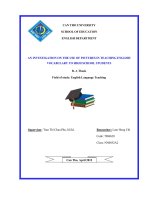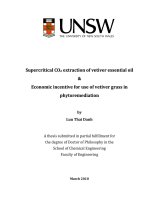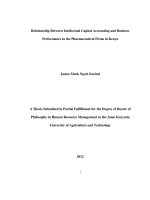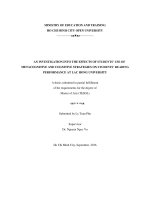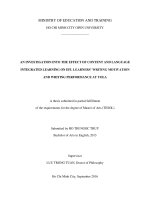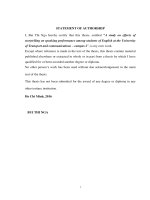Impacts of video assisted teaching on truong dinh high school students perceptions towards the practice of listening a thesis submitted in partial fulfillment of the requirements for the
Bạn đang xem bản rút gọn của tài liệu. Xem và tải ngay bản đầy đủ của tài liệu tại đây (1.35 MB, 136 trang )
MINISTRY OF EDUCATION AND TRAINING
HO CHI MINH CITY OPEN UNIVERSITY
IMPACTS OF VIDEO- ASSISTED TEACHING
ON TRUONG DINH HIGH SCHOOL
STUDENTS’ PERCEPTIONS TOWARDS
THE PRACTICE OF LISTENING
A thesis submitted in partial fulfillment of the requirements
for the degree of Master of Arts in TESOL
Submitted by: LE THI KHUYEN
Supervisor: LE THI THANH THU, Ed. D.
HO CHI MINH City, October 2016
STATEMENT OF AUTHORSHIP
I certify that this thesis entitled “Impacts of using video-assisted teaching on
Truong Dinh high school students’ learning listening” is my own work.
Except where reference is made in the text of the thesis, the thesis does not contain
material published elsewhere or extracted in whole or in part from a thesis by which I
have qualified for or been awarded another degree or diploma.
This thesis has not been submitted for the award of any degree or diploma in other
institutions as well as no other person’s work has been used without the acknowledge in
the main text.
Ho Chi Minh City, October 2016
Le Thi Khuyen
i
RENTENTION AND USE OF THE THESIS
I hereby state that I, LE THI KHUYEN, being the candidate for the degree of Master of
TESOL, accept the requirements of the University relating to the retention and use of
Master's Theses deposited in the Library.
In terms of these conditions, I agree that the original copy of my thesis deposited in
the Library should be accessible for purposes of study and research in accordance with
the normal conditions established by the Library for the care, loan and reproduction of
theses.
Ho Chi Minh City, October 2016
Le Thi Khuyen
ii
ACKNOWLEGEMENTS
I would like to express my deepest gratitude to my thesis supervisor, Dr. Le Thi
Thanh Thu, for her treasured and invaluable support over the course of this study. With
the insightful guidance and encouraging spirit, my supervisor helped me a lot to finish the
thesis. She was always available for reading and commenting on my work. Thanks to her
constant guidance and valuable comments, the thesis has become a complete piece of
work.
I would also like to thank all the English teachers in the Open University for their
valuable instructions during the course, as well as other staff at this university for their
necessary support during my studies.
My gratitude also goes to all administrators of Truong Dinh high school, who created
opportunities and good conditions for me to complete the course at Ho Chi Minh Open
University.
I was thankful to my students at Truong Dinh high school, Tien Giang province for
their cooperation. Finally yet importantly, I am deeply thankful to my family, especially
my husband whose encouragement helped me overcome difficulties during my
conducting my thesis.
iii
LIST OF ABBREVIATION
1. DOET
:
Department of Education and Training
2. MOET
:
Ministry of Education and Training
3. GTM
:
Grammar-Translation Method
4. CLT
:
Communicative language teaching
5. CG
:
The control group
6. EG
:
The experimental group
7. Ss
:
Students
iv
ABSTRACT
The purpose of the study was to explore students’ attitudes towards the use of video and
the impacts of videos on students’ listening skill at Truong Dinh high school. To achieve
these purposes, an experimental research was employed. This study lasted in three
months with two- group design of 80 tenth grade students. One set of questionnaire and
two tests were used to as instruments for data collection. The pre-test extracted from the
listening part of the first term examination was used to divide 80 students into two
groups. After video materials were applied in four weeks of the treatment, Test 1 was
held to evaluate the ability of listening comprehension of two groups. Next, Test 2 was
administrated to the students of the two groups at the end of the treatment. Right after the
Test 2, a set of questionnaire was delivered to only 41 students of the experimental group
to find out their attitudes towards the learning listening through video. The results proved
that students learning with videos had significantly better results than students learning
with cassette players. Those students turned out to be active and engaged in their learning
listening and had positive attitudes towards learning listening. This led to the suggestion
that videos should be implemented into the language learning in the classroom to help
students develop their listening ability.
v
TABLE OF CONTENTS
Page No
Statement of the authorship .................................................................................... i
Retention and use of the thesis .............................................................................. ii
Acknowledgements .............................................................................................. iii
List of abbreviations ............................................................................................. iv
Abstract .................................................................................................................. v
Table of contents .................................................................................................. vi
List of tables .......................................................................................................... x
CHAPTER 1: INTRODUCTION
1.1. Rational for the thesis ..................................................................................... 1
1.2. The objectives of the study…………………… ............................................. 4
1.3. Research questions ......................................................................................... 4
1.4. Scope of the study…………………… .......................................................... 4
1.5. Background to the study ................................................................................. 5
1.5.1. Grade 10 teachers and students at Truong Dinh high school ..................... 5
1.5.1.1. Grade 10 teachers ..................................................................................... 5
1.5.1.2. Grade 10 students ..................................................................................... 6
1.5.2. Teaching and learning listening at Truong Dinh high school ..................... 7
1.5.3. Materials…………………… ...................................................................... 7
1.6. Significance of the study ................................................................................ 9
1.7. Organization of the study ............................................................................... 9
CHAPTER 2: LITERATURE REVIEW
2.1. The basic concept of listening ...................................................................... 11
2.1.1. Definition of listening ................................................................................ 11
2.1.2. Procedure of learning listening .................................................................. 12
vi
2.1.3. Listening process ....................................................................................... 13
2.1.4. Factors affecting learning listening ........................................................... 14
2.1.4.1. Learners’ attitudes .................................................................................. 14
2.1.4.1.1. Definition ............................................................................................. 14
2.1.4.1.2. The effects of learners’ attitudes on the language learning ................. 15
2.1.4.2. Attention in the learning listening process ............................................. 17
2.1.4.3. Relevant of listening inputs .................................................................... 17
2.1.4.4. Fundamental knowledge used in students’ listening .............................. 19
2.2. Videos ........................................................................................................... 19
2.2.1. Types of videos .......................................................................................... 20
2.2.2. Advantages of using videos ....................................................................... 21
2.2.3. Disadvantages of using videos .................................................................. 23
2.2.4. Selecting videos ......................................................................................... 24
2.2.5. Implementing videos in the classroom ...................................................... 25
2.3. Previous studies ............................................................................................ 27
CHAPTER 3: METHODOLOGY
3.1. Research design ............................................................................................ 31
3.2. Research site ................................................................................................. 31
3.3. Participants ................................................................................................... 32
3.4. Application of videos .................................................................................. 34
3.4.1. Research procedure.................................................................................... 34
3.4.2. Teaching/ Learning materials .................................................................... 36
3.4.2.1. Teaching/ Learning materials of the control group ................................ 36
3.4.2.2. Teaching/ Learning materials of the experimental group ...................... 38
3.5. Data collection instruments .......................................................................... 39
3.5.1. Questionnaire ............................................................................................. 39
3.5.2. Tests ........................................................................................................... 41
3.6. Data collection procedures ........................................................................... 41
3.7. Data analysis ................................................................................................. 42
vii
CHAPTER 4: DATA ANALYSIS AND INTERPRETATION
4.1. Data analysis methodology........................................................................... 43
4.2. Questionnaire analysis and discussion ......................................................... 44
4.2.1. Students’ general perceptions on learning listening .................................. 44
4.2.2. Students’ perceptions on the benefits of the use of videos and their
feelings towards it .............................................................................................. 46
4.2.3. Students’ desire to learn listening through videos ..................................... 53
4.3. Test analysis and discussion ......................................................................... 54
4.3.1. Pre-test between CG and EG ..................................................................... 55
4.3.2. Pre-test and Test 1 ..................................................................................... 56
4.3.2.1. Comparison of CG Pre-test and Test 1 .................................................. 57
4.3.2.2. Comparison of EG Pre-test and Test 1 ................................................. 58
4.3.3. Test 1 and Test 2 ........................................................................................ 59
4.3.3.1. Comparison of CG Test 1 and Test 2 ..................................................... 59
4.3.3.2. Comparison of EG Test 1 and Test 2 ..................................................... 60
4.3.4. Comparison of Tests between CG and EG ............................................... 62
4.3.4.1. Comparison of Test 1 between CG and EG .......................................... 62
4.3.4.2. Comparison of Test 2 between CG and EG .......................................... 63
4.4. Chapter summary.......................................................................................... 66
CHAPTER 5: CONCLUSIONS AND RECOMMENDATIONS
5.1. Summary of the study ................................................................................... 67
5.2. Implication .................................................................................................... 70
5.3. Suggestions for the further studies ............................................................... 71
REFERENCES .................................................................................................. 73
APPENDICES
APPENDIX 1: Questionnaire for experimental students (English version) ...... 81
APPENDIX 2: Questionnaire for experimental students (Translated version) . 85
APPENDIX 3: Test 1 ......................................................................................... 89
APPENDIX 4: Test 2 ......................................................................................... 93
viii
APPENDIX 5: Training procedure for CG and EG .......................................... 96
APPENDIX 6: Lesson plans for the experimental teaching practice .............. 100
APPENDIX 7: Scores of the control group...................................................... 122
APPENDIX 8: Scores of the experimental group ............................................ 124
ix
LIST OF THE TABLES
Page No
Table 3. 1. Results of the first term examination of class 10 1, 10, 13 .................... 31
Table 3. 2. The experiment time plan ................................................................. 32
Table 4. 1. Students’ general perceptions on learning English teaching ........... 43
Table 4. 2. Students’ general perceptions on the benefits of videos in learning
listening .............................................................................................................. 45
Table 4. 3. Students’ feelings towards the application ........................................ 50
Table 4. 4. Students’ desire to learn listening through videos ........................... 51
Table 4. 5. Comparison of Pre-test between CG and EG .................................... 53
Table 4. 6. Comparison of CG Pre-test and Test 1 .............................................. 55
Table 4. 7. Comparison of EG Pre-test and Test 1. ............................................. 56
Table 4. 8. Comparison of CG Test 1 and Test 2 ................................................ 58
Table 4. 9. Comparison of EG Test 1 and Test 2 ............................................... 59
Table 4. 10. Comparison of Test 1 between CG and EG .................................. 60
Table 4. 11. Comparison of Test 2 between CG and EG .................................. 60
x
CHAPTER 1
INTRODUCTION
1.1.
Rationale for the thesis
In the world today, in trend of the global integration of education, science,
technology, business, and diplomacy, English is considered as a bridge to promote the
relationship and mutual understanding among the countries. In Vietnam context, there is
an increase the demand of English competence among officers, workers and especially
students who need to interact with foreigners at work, business, and educational training.
Therefore, English has become an important part in Vietnam‟s policy of economics and
education development. At the moment, the goal of teaching and learning English in
Vietnam is to develop students‟ communicative competence of English. Students are
expected to be able to interact with their counterpart well when learning English. If they
cannot listen well, there is likely that they will have no good communication too.
Therefore, students will not build good relationship with their classmates in the
classroom and their colleagues at work afterward. As for that reason, an ability to listen
necessary for students from high schools to colleges and universities.
Although listening is a challenging skill for student to master, it is considered as
the language skill used most frequently in daily communication as well as in the language
learning. According to Holden (2004), listening comprehension plays a vital role in
helping learners to acquire a language. It helps learners to get other language skills.
Vandergrift (2007) considers listening as the heart of both first and second language
learning because it influences directly on the development of all other language skills.
Guo and Wills (2006) say that listening takes the role of the foundation for all facets of
language acquisition as well as makes it possible for learners to interact orally. However,
despite its benefits, listening is really a difficult skill to develop because various factors
make the language more complicated at the moment of listening and understanding it.
1
These factors are known as stress, pronunciation, accents, and the cultural component
which consists of expressions, jargons and idioms…. This leads to the fact that students
often cope with failure in listening in their learning foreign language.
Up to now, attempts have been made by the Ministry of Education and Training
(MOET) to develop curricula to help Vietnamese students to develop their competence in
using the four language skills. Among them is the National Project (Project 2020) for
teaching and learning foreign language which was initiated by MOET. This National
Project aims to develop Vietnamese students‟ communicative skills including speaking
and listening skills (Nguyen, 2008). For high school level, in line with this initiation was
the introduction of two sets of the new textbooks known as the advanced textbooks “Sách
nâng cao” and the standard textbooks “Sách chuẩn”. At the moment, the standard
textbooks are being used as the materials for teaching and learning at Truong Dinh high
school.
However, despite some positive results from students‟ learning through this kind
of material in developing the four language skills, their listening skills are still limited.
There might be two reasons explaining for this. The first is that listening is the skill
requiring learners a lot of effort and concentration. The second is that listening is the skill
that is rarely taught at schools. Teachers rushed for other fields of language learning
(such as grammar, writing…) which mainly constitute the students‟ exams and did not
pay much attention to listening teaching because of its limited volume from all the
exams. As a result, in the interaction with other people, students usually deal with the
failure in their listening.
More seriously, this led to the strong possibility of communication breakdown if
students could not listen properly. Besides, students were not motivated in developing
listening skills while it is very necessary for them to form communication skill to meet
the requirements of globalization and needs for future jobs. From the reasons mentioned
above, improving the student‟ listening ability of English is necessary and teachers‟
2
duty is to help their students to adequately focus on the four skills, and especially to find
interest in learning listening.
To seek a solution to such problems, the educators have applied different teaching
and learning techniques to improve learners‟ listening ability. The application of
technology in the classroom in Vietnam has been consideration recently and has been
recognized as a tool to assist teachers of English in language teaching and learning.
Recent studies concerning the use of video- assisted teaching in teaching listening have
revealed the benefits of this method. Learning listening with videos, students pay most
their attention to video and acquire most words by associating them with visual images.
As a result, videos tend to aid recognition of the learning of word meaning. They can
improve students‟ listening comprehension because they help to facilitate recognition of
aural forms (Winke, Gass, & Sydorenko, 2010). Moreover, according to many
researchers, in the learning listening process, students need to receive as much
comprehension input as possible which helps them achieve the objective of language
learning. The application of video- assisted teaching in students‟ learning listening can
meet this requirement through which students can be enhanced their understanding of
listening lessons by the images, the facial expression of the characters in videos.
Because of the benefits that students receive during the learning of listening with
the support from video- assisted teaching, in this study, videos are proposed as one of the
sources of learning materials or input for English listening learning because they can
provide an abundant source of conversations and dialogues of English speakers.
Moreover, videos can facilitate students‟ comprehension of pronunciation. According to
Secules, Herron &Tomasello (1992, cited in Keihaniyan, 2013), video-based instruction
is preferable to audio only instruction in listening learning because it multiplies input
modalities. Lonergan (1994, cited in Lustigová, 2013) says that videos have the ability to
present “complete communicative situations”, thus they can provide samples of real-life
communication to motivate students‟ learning listening and promote their language
acquisition. Additionally, it can motivate learners and attract their attention to the aural
input. For these reasons, the researcher decided to look closely at the idea of
3
implementing videos in listening learning at Truong Dinh high school with the strong
belief that the more students are exposed to video materials in their learning listening, the
more effectively and interestingly they learn.
1.2.
The objectives of the study
This study aims to examine the impacts of videos- assisted teaching on Grade 10
students‟ English listening learning at Truong Dinh high school. The impacts investigated
include students‟ attitudes toward the implication of videos in their learning process and
the possible improvement of students‟ listening ability.
1.3.
Research questions
In order to find out the answers clarifying the objectives above, there are two
questions taken into consideration:
1. What are students‟ attitudes towards the application of videos in English listening
learning?
2. To what extent does video-assisted teaching help improve students‟ listening ability?
1.4.
Scope of the study
This study focused on investigating the impacts of using videos for Grade 10
students who were basic education mayors. They were following the English national
curriculum introduced by MOET (Ministry of Education and Training) in 2006 and used
for the secondary school education. Methodologically, this new curriculum aims to adopt
the communicative approach to language teaching by which students‟ communicative
4
skills are formed and developed. Besides, MOET (2006:6) showed that this new
curriculum emphasizes the active role of students in the teaching and learning process.
The construction of the English 10, 11, 12 textbooks was based on this new national
curriculum. Each of the textbooks is accompanied with student‟ workbooks, teacher‟s
manual and cassette tapes and all units in the textbooks are divided into five sections:
Reading, Speaking, Listening, Writing and Language Focus in which Listening lesson is
instructed into three stages: pre-listening, while-listening and post-listening.
In the pre-listening step, students are motivated to listen, activated their
background knowledge as well as provided vocabulary before they listen. In whilelistening step, they are instructed to develop micro-skills known as listening for general
understanding, listening for specific or detailed information or taking the form of
matching exercises, True-False questions, multiple choice questions and open-minded
questions. In the post-listening step, student‟s activities are around the text summary and
reproduction in oral or written forms and discussion of the topic. In this study, to
determine if videos enhance students‟ listening in comparison with cassette players, the
researcher applied videos at the while-listening stage of the lesson while students were
still exposed to the other stages in the same way as learning with cassette players. The
time for conducting this study was in eight weeks, in the second semester of their school
year.
1.5.
Background to the study
1.5.1. Grade 10 teachers and students at Truong Dinh high school
1.5.1.1. Grade 10 teachers
Truong Dinh high school, established in 1954 in Go Cong town, is considered one
of the best high schools of the Tien Giang province by the evaluation of the Department
of Education and Training (DOET). There are 98 teachers of the whole school with ten
5
English teachers. Six of them are teaching Grade 10 at the moment. The English teachers
graduated from different universities with different forms of training. As a consequence,
they were varied in their English proficiency.
Methodologically, teachers are familiar with the Grammar-Translation method
(GTM), which emphasizes students‟ language competence. Despite the innovation in
teaching listening skill which requires teachers to apply the Communicative language
teaching (CLT), teaching listening is considered as a new perspective at this school.
Teachers are required to change their teaching method, applying CLT, which aims to
develop students‟ communicative ability. However, because of the requirement of exams,
teachers are still forced to put their attention on teaching reading comprehension and
grammar. As a result of this, teaching listening at this school has not really been much
efficient and appreciated.
1.5.1.2. Grade 10 students
At the moment, there are 1,700 students at Truong Dinh high school and 570 of
them are Grade 10 students who are assigned into 13 classes. All of them learn English as
a compulsory subject with 3 periods a week for classes of natural science majors and
basic education majors. The results from the entrance examination to enter Truong Dinh
high school showed that Grade 10 students‟ English competence is rather low. The reason
might come from students themselves. Firstly, to many students, English is really a hard
subject with many complex terms of vocabulary and grammar structures, pronunciation,
intonation… which take them a lot of time and effort to learn. Therefore, many of them
may just learn English to pass their examinations, not because of their interests.
Secondly, students here lack vocabulary, social-cultural background and contextual
knowledge of the English language. These things are barriers to their language learning,
including their listening. Besides, with the time of 45 minutes per lesson for listening,
many students may not have chances to practice listening regularly so their listening is
not good. These difficulties mentioned above discourage students from learning listening
6
and make them feel that learning listening is one of most difficult and boring aspects in
their learning English language.
1.5.2. Teaching and learning listening at Truong Dinh high school
All in all, the teaching listening at Truong Dinh has four characteristics. Firstly,
that listening was carried out in monotonous and repeated way was still common here.
Teachers often carried out their listening lesson in the same approach which includes
introducing some new words, having students listen to the tape two or three times, asking
questions and giving correct answers. Secondly, most teachers here focused largely on
grammar explanations or reading teaching. This can be explained by the reason that
teachers at Truong Dinh high school mainly focused on reading comprehension, writing
and grammar to help students meet the requirements of passing the high school tests and
examinations …. Meanwhile, listening because of its minor part in assessments, does not
gain much attention from both English teachers and students.
Thirdly, teaching listening here seems to lay emphasis on the product rather than on
the process. According to Sheerin (1987); Richards (1983) and White (2006), this leads
to the fact that teaching listening is virtually testing listening as well as results in anxiety
or even resistance from the learners. Finally, although listening appears in the first,
second semester examination, it accounts for a rather small part, varied from 1 to 1.5
points in each test. As a result, students seem not to recognize its important role in
studying and they even do not want to improve their listening competence.
1.5.3. Materials
For high school level, there are two sets of the new textbooks. One set is standard
textbooks “Sách chuẩn” and the other is advanced textbooks “Sách nâng cao”. Each set
consists of three books, from English 10 to English 12, accompanied by respective
student‟s workbooks and teacher‟s manuals and cassette tapes. At present, the standard
7
textbooks are used as the official source of teaching and learning English at Truong Dinh
high school. There are 16 teaching units and six review units in each book in which each
teaching unit has its own topic and is divided into five sections (as mentioned in the
section 1.4) in the time of 45 minutes for each section. Besides, in the standard textbook,
Reading skills are introduced first to provide students with language input and ideas for
other language skills (speaking, listening, writing and language focus) in turn. The
glossary at the end of each textbook containing phonetic transcription and Vietnamese
translation is based on the system of transcription symbols of Oxford Advanced Learner
Dictionary (7th edition) (English 10: 4, English 11: 4).
From the researcher‟ point of view; this new textbook has much contribution to
better quality of English language learning including the listening aspect. Students have
made progress in their listening ability. However, the division of micro-skills in the
listening lessons is not equal. The popular skills used in the listening lessons in this
textbook are listening for detailed understanding and listening for specific in turn. The
repetition in doing the same kind of tasks made students feel bored as well as were not
motivated in their learning listening. Meanwhile, listening for gist skill, though
mentioned in the syllabus requirement seems not to be chosen as an important skill for
students to develop in their learning listening. They are even under-represented in these
units of the textbook. Other micro-skills such as inferring meaning from the listening
context, note-taking while listening…thinly appeared in the textbook. Besides, in the
while-listening stage, the listening questions are simple, some are rather factual and
straightforward, therefore, do not require students‟ processing of the information at a
deep level. Students are not motivated with such these kinds of questions because they
are not suitable with the situations in the real life and listening in the real life is more
challenging.
Moreover, because the language proficiency levels are different among students,
especially students‟ levels are generally better than those of rural students. Some of them
have difficulties in understanding the language in the listening lessons and seem not to
8
utilize the convenient conditions when they learn this new textbook. Students at Truong
Dinh high school, like other students at other schools in the rural area, have to face
problems when learning listening with textbook. That students usually practice their
listening with audio tapes without visual supports also makes their learning listening
limited. Students are not helped much from the poor input in the listening text and they
do not listen effectively during their listening in the while-listening step. This explains for
the reason why students are difficult to master the meaning of content in the tapes as well
as why the results from their listening learning are limited. With the immense advantages
from which students can benefit in their listening learning, videos are suggested as the
replacing materials to help students to overcome these obstacles above and gain much
improvement in their learning listening.
1.6.
Significance of the study
The current study is supposed to provide a general overview of impacts of using
videos on grade 10 students‟ listening at Truong Dinh high school. Therefore, the study is
likely to be able to assist students to learn listening better and efficiently, right in the
classroom. Besides, the results from this study can be used as reference for English
teachers to apply in their teaching listening as well as develop their teaching listening
techniques. Last but not least, the study can provide references for further research in this
field of study.
1.7.
Organization of the study
The thesis includes five chapters with their own aims and contents. Chapter 1,
Introduction, provides the background of the study. It describes the situation of teaching
and learning English listening for Grade 10 students at Truong Dinh high school, presents
the rationale for the using videos in teaching listening comprehension and establishes the
9
research questions of the study. Meanwhile, Chapter 2, Literature review, concerns the
literature. In this chapter, the researcher presents relevant and fundamental literature to
the study. Apart from the basic concept of listening and videos, the advantages and
disadvantages of video applications are presented as well.
Chapter 3, Methodology, deals with the design and methodology of the
investigation in which two main data collection instruments were employed. The first one
was questionnaires for Grade 10 Truong Dinh high school students and the second one
was the tests (one in the middle and one at the end of the survey). Chapter 4, Data
analysis and findings, presents the data analysis and discussion as well as the findings
about the impact of using videos on Truong Dinh high school students‟ listening
comprehension. Finally, Chapter 5 offers implications and suggestions for teachers and
learners for further research.
10
CHAPTER 2
LITERATURE REVIEW
The aim of the current study is to explore the use of videos as a useful tool helping
students in their listening learning. Therefore, in this chapter, the researcher aims to shape
the conceptual framework of the study, beginning with the concept of listening together
with the basic concept of materials and videos. Next, it provides a brief summary of
advantages and disadvantages of using videos in the classroom that learners may get
when they are exposed to them in their learning listening.
2.1. The basic concept of listening
2.1.1. Definition of listening
Listening is the ability to identify and understand what others are saying, including
the understanding a speaker‟s accent and pronunciation, his/her grammar and his/her
vocabulary as well as grasping his/her meaning. According to Underwood (1989),
listening is the activity in which learners pay attention to and try to get meaning from
something they hear. From his viewpoint, it can be seen that listening is an activity which
depends on learners‟ competence to know the meaning of what they hear. Agreeing with
his idea, Hedge (2000) also says that listening ability will develop automatically through
exposure to the language and through practice of grammar, vocabulary, and
pronunciation.
Meanwhile, some other researchers consider listening as a process which requires
not only verbal but nonverbal information. According to Steinberg (2007), listening is
more complex than merely hearing. It is a process consisting of four stages: sending and
attending, understanding and interpreting, remembering, and responding…. He also
asserts that these stages occur in sequences but we are unaware of them. Specifically,
Ford (1985) says that listening is a process of hearing, attending to, evaluating, and
11
responding to spoken message. Listeners receive speech sounds and try to combine
meaning to the spoken words to understand the message of the speaker in order that they
can respond to oral communication effectively.
However, Rubin (1990) and Brownell (2015) have a further view than Ford (1985)
when they state that listening consists of the process of receiving, constructing meaning
and responding to spoken and /or nonverbal messages. This means that listening not only
consists of a spoken language but also nonverbal messages. In short, it can be seen from
these mentioned above that besides being the perception of verbal messages, listening is
also an active process. It needs the combination of attending, receiving, building
meanings so that learners can understand and respond to speakers‟ sayings.
2.1.2. Procedure of learning listening
On the www.nclrc.org/essentials/listening/liindex.htm, the procedure of listening in
the classroom develops from the three stages: pre-listening, while-listening, and postlistening. In the pre-listening stage, students prepare for their learning when are
introduced the topic of the lesson by their teacher. They also find out what they have
already known about this topic. In this stage, students are expected to practice their
brainstorming sessions or discussion questions. These activities provide the necessary
background information and new vocabulary which are very useful for students when
they begin to listen.
The while-listening stage is the one which is specific about what students are
required to listen for. In this stage, students are expected to listen and do the tasks. All in
all, there are many kinds of tasks such as listening for gist, listening for main ideas,
summarizing or making interference. Students can listen for the general content or
selective details to fulfill these kinds of tasks and develop their listening skill in this
stage. In the post-listening, students will finish their listening lesson with an activity to
extend the topic of the lesson and reinforce their vocabulary. The suitable activities for
this stage may be a discussion group, craft project, games or writing tasks. In short, the
12
post-listening tasks are the stage students use their knowledge from their listening lesson
for their further language practice.
2.1.3. Listening process
Nunan (1991) says that there are two processes of listening known as bottom-up
and top-down. In the bottom-up process, students use linguistics knowledge to
understand the meaning of the message of the listening text. Their build their
understanding the meaning from lower level of sounds to words and then from
grammatical relationship to lexical meanings so that they can finally understand the
whole messsage. By contrast, students use top-down process when they need their prior
knowledge to understand the meaning of a message. They have to use the knowledge of
the topic, the listening context, the text-type, the content words and contextual clues to
form their understand their listening lesson.
Like Nunan, Wagner (2002) also made a Model of Second language Listening
Comprehension showing the important components of listening ability. He suggested that
there were two processes listening known as top-down and bottom-up which occur
simultaneously during students‟ listening learning and, therefore, they are interrelated.
These observable listening skills such as identifying details, facts, supporting ideas…
apparrently constitute the ability to do bottom-up processing. Meanwhile, the global skills
as listening for gist, making inferences, or deducting vocabulary through context of the
text are the ones representing the latent ability to perform top-down processing. It can be
concluded from the two researchers‟ opinions that listening process is a complex and
interrelated one because the two top-down and bottom-process take place at the same
time. Therefore, students have to select suitable strategies ot techniques so that they can
utilize the listening input they receive in the most effective way to get the best result in
their listening learning.
13
2.1.4. Factors affecting learning listening
Factors affecting learning listening with videos consist of learners‟ attitudes,
attention, relevant features of listening inputs and fundamental knowledge used in
listening process. They are known as the ones influence students‟ learning listening and
decide whether students learn listening successful or not.
2.1.4. 1. Learners’ attitudes
2.1.4.1.1. Definition
Up to the present, attitudes have drawn a lot of considerable attention from the
researchers on this isue. They agree that learners‟ attitude is an important part of learning
and an essential factor of second language learning. Ajzen (1989) says that attitudes refer
to people‟s disposition to respond to an object, person, institution or event in a favourable
or unfavourable way. Baker (1992) also asserts that attitudes are considered as a
hypothetical construct through which the direction and persistence of human behaviour is
explained. Meanwhile Brown (2001) says that the emotional involvement known as
feelings, self, relationships in the community are factors characterizing the atttitudes that
affect significantly learners‟ language learning.
Wenden (1991) says that the term “attitude” consists of three components which
are known as emotional, cognitive and behavioral. Among them, the first component, the
emotional aspect of attitudes, involves the individual‟s feelings and emotions towards an
object. This component usually represents an individual‟s emotional response ot the
feeling of liking to a person or an object. According to Feng and Chen (2009), language
learning is an emotional process in which both teacher and his/her students engage in
various emotional activities. In addition, various fruits of emotions are also formed
through it. Troudi & Choy (2006) state that attitudes can help students to express whether
they like or dislike the knowledge of the object that they are exposed to during their
language learning. The inner feelings and emotions of the students put strong impacts on
14


